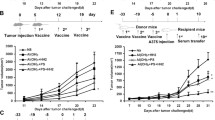Abstract
New anticancer vaccines must overcome regulatory T cell (Treg)-mediated immunosuppression. We previously reported that oral ingestion of Lentinula edodes mycelia (L.E.M.) extract restores melanoma-reactive T cells in melanoma-bearing mice via a mitigation of Treg-mediated immunosuppression. In this study, we investigated the effect of oral ingestion of the extract on peptide vaccine-induced anti-tumor activity. The day after subcutaneous inoculation in the footpad with B16 melanoma, mice were freely fed the extract and were vaccinated with a tyrosinase-related protein 2180–188 peptide. The peptide vaccine was repeated thrice weekly. Melanoma growth was significantly suppressed in mice treated with both the peptide vaccine and L.E.M. extract compared with mice treated with vaccine or extract alone, and the effect was CD8+ T cell-dependent. The combination therapy increased H-2Kb-restricted and B16 melanoma-reactive T cells in the draining lymph nodes and spleen. Flow cytometric and immunohistological analyses revealed that the combination therapy significantly decreased the percentage of Tregs in the draining lymph nodes and spleen of melanoma-bearing mice compared to treatment with vaccine or extract alone. Kinetic analyses of peptide-specific T cells and Tregs revealed that induction of peptide-specific T cells by the peptide vaccine alone was transient, but when combined with L.E.M. extract, it efficiently prolonged the duration of peptide-specific T cell induction without increasing the percentage of Tregs. These results indicate that combination therapy enhances peptide vaccine-induced anti-tumor activity due to attenuation of the increase in the percentage of Tregs in tumor-bearing hosts.






Similar content being viewed by others
References
Rosenberg SA, Yang JC, Schwartzentruber DJ et al (1998) Immunologic and therapeutic evaluation of a synthetic peptide vaccine for the treatment of patients with metastatic melanoma. Nat Med 4:321–327
Nestle FO, Alijagic S, Gilliet M et al (1998) Vaccination of melanoma patients with peptide-or tumor lysatepulsed dendritic cells. Nat Med 4:328–332
Jager E, Gnjatic S, Nagata Y et al (2000) Induction of primary NY-ESO-1 immunity: CD8+ T lymphocyte and antibody responses in peptide-vaccinated patients with NY-ESO-1+ cancers. Proc Natl Acad Sci USA 97:12198–12203
Oka Y, Tsuboi A, Fujiki F et al (2009) WT1 peptide vaccine as a paradigm for “cancer antigen-derived peptide”-based immunotherapy for malignancies: successful induction of anti-cancer effect by vaccination with a single kind of WT1 peptide. Anticancer Aqents Med Chem 9:787–797
Mine T, Sato Y, Noguchi M et al (2004) Humoral responses to peptides correlate with overall survival in advanced cancer patients vaccinated with peptides based on pre-existing, peptide-specific cellular responses. Clin Cancer Res 10:929–937
Schwartzentruber DJ, Lawson DH, Richards JM et al (2011) gp100 peptide vaccine and interleukin-2 in patients with advanced melanoma. N Engl J Med 364:2119–2127
Rosenberg SA, Yang JC, Restifo NP (2004) Cancer immunotherapy: moving beyond current vaccines. Nat Med 10:909–915
Yamaguchi T, Sakaguchi S (2006) Regulatory T cells in immune surveillance and treatment of cancer. Semin Cancer Biol 16:115–123
Ostrand-Rosenberg S, Sinha P (2009) Myeloid-derived suppressor cells: linking inflammation and cancer. J Immunol 182:4499–4506
Curiel TJ, Coukos G, Zou L et al (2004) Specific recruitment of regulatory T cells in ovarian carcinoma fosters immune privilege and predicts reduced survival. Nat Med 10:942–949
Sato E, Olson SH, Ahn J et al (2005) Intraepithelial CD8+ tumor-infiltrating lymphocytes and a high CD8+/regulatory T cell ratio are associated with favorable prognosis in ovarian cancer. Proc Natl Acad Sci USA 102:18538–18543
Loeffler M, Kruger JA, Reisfeld RA (2005) Immunostimulatory effects of low-dose cyclophosphamide are controlled by inducible nitric oxide synthase. Cancer Res 65:5027–5030
Wada S, Yoshimura K, Hipkiss EL et al (2009) Cyclophosphamide augments antitumor immunity: studies in an autochthonous prostate cancer model. Cancer Res 69:4309–4318
Ghiringhelli F, Larmonier N, Schmitt E et al (2004) CD4+ CD25+ regulatory T cells suppress tumor immunity but are sensitive to cyclophosphamide which allows immunotherapy of established tumors to be curative. Eur J Immunol 34:336–344
Onizuka S, Tawara I, Shimizu J, Sakaguchi S, Fujita T, Nakayama E (1999) Tumor rejection by in vivo administration of anti-CD25 (interleukin-2 receptor alpha) monoclonal antibody. Cancer Res 59:3128–3133
Tawara I, Take Y, Uenaka A, Noguchi Y, Nakayama E (2002) Sequential involvement of two distinct CD4+regulatory T cells during the course of transplantable tumor growth and protection from 3-methylcholanthrene-induced tumorigenesis by CD25-depletion. Jpn J Cancer Res 93:911–916
Yamaguchi T, Hirota K, Nagahama K et al (2007) Control of immune responses by antigen-specific regulatory T cells expressing the folate receptor. Immunity 27:145–159
Tanaka K, Ishikawa S, Matsui Y, Tamesada M, Harashima N, Mamoru H (2011) Oral ingestion of Lentinula edodes mycelia extract inhibits B16 melanoma growth via mitigation of regulatory T cell-mediated immunosuppression. Cancer Sci 102:516–521
Harada M, Tamada K, Abe K et al (1998) Characterization of B16 melanoma-specific cytotoxic T lymphocytes. Cancer Immunol Immunother 47:198–204
Kojima H, Akaki J, Nakajima S, Kamei K, Tamesada M (2010) Structural analysis of glycogen-like polysaccharides having macrophage-activating activity in extracts of Lentinula edodes mycelia. J Nat Med 64:16–23
Zeh HJ III, Perry-Lalley D, Dudley ME, Rosenberg SA, Yang JC (1999) High avidity CTLs for two self-antigens demonstrate superior in vitro and in vivo antitumor efficacy. J Immunol 162:989–994
Kato Y, Adachi Y, Ohno N (2008) Characterization of rat beta-glucan receptor dectin-1. Microbiol Immunol 52:418–428
Manicassamy S, Ravindran R, Deng J et al (2009) Toll-like receptor 2-dependent induction of vitamin A-metabolizing enzymes in dendritic cells promotes T regulatory responses and inhibits autoimmunity. Nat Med 15:401–409
Muraoka D, Kato T, Wang L et al (2010) Peptide vaccine induces enhanced tumor growth associated with apoptosis induction in CD8+ T cells. J Immunol 185:3768–3776
Zhou LD, Zhang QH, Zhang Y, Liu J, Cao YM (2009) The shiitake mushroom-derived immuno-stimulant lentinan protects against murine malaria blood-stage infection by evoking adaptive immune-responses. Int Immunopharmacol 9:455–462
Lu H, Yang Y, Gad E et al (2011) Polysaccharide krestin is a novel TLR2 agonist that mediates inhibition of tumor growth via stimulation of CD8T cells and NK cells. Clin Cancer Res 17:67–76
Lee KS, Scanga CA, Bachelder EM, Chen Q, Snapper CM (2007) TLR2 synergizes with both TLR4 and TLR9 for induction of the MyD88-dependent splenic cytokine and chemokine response to Streptococcus pneumoniae. Cell Immunol 245:103–110
Yoshioka Y, Tamesada M, Nagayama A (2009) The safety of excessive intake of the food containing extract of cultured Lentinula edodes mycelia (LEM) in healthy adult volunteers. JCAM 6:9–15 (in Japanese)
Yoshioka Y, Matsui Y, Kobayashi M et al (2010) Safety evaluation of extract from cultured Lentinula edodes mycelia; study of acute toxicity, genotoxicity and inhibiting effect of drug-metabolizing enzyme, cytochrome P-450 3A4. JCAM 7:51–57 (in Japanese)
Conflict of interest
The authors declare that they have no conflict of interest.
Author information
Authors and Affiliations
Corresponding author
Electronic supplementary material
Below is the link to the electronic supplementary material.
Rights and permissions
About this article
Cite this article
Tanaka, K., Ishikawa, S., Matsui, Y. et al. Combining a peptide vaccine with oral ingestion of Lentinula edodes mycelia extract enhances anti-tumor activity in B16 melanoma-bearing mice. Cancer Immunol Immunother 61, 2143–2152 (2012). https://doi.org/10.1007/s00262-012-1275-8
Received:
Accepted:
Published:
Issue Date:
DOI: https://doi.org/10.1007/s00262-012-1275-8




